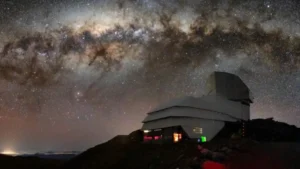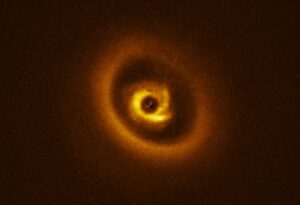In the far reaches of our solar system, scientists have discovered a ringed planet that should not exist.
More accurately, it’s the size of the dwarf planet’s ring that has confounded astronomers. It has led them to reexamine the physics of these cosmic wonders.
The Pluto-sized celestial body is called Quaoar, and it orbits in the Kuiper Belt, just beyond Neptune. The European Space Agency caught rare glimpses of it through its space-based telescope Cheops. Astronomers watched as Quaoar passed in front of a succession of distant stars in the viewing field, briefly blocking out their light.
It’s called an occultation event, meaning the planet’s sharp silhouette can be briefly observed by telescopes. But astronomers didn’t just spot the small planet during their observation. According to findings published in Nature on Wednesday, they also recorded two smaller dips in starlight before and after — indicating a ring system.
And not just any ring system, but a far wider ring than astronomers had believed possible.
“The ring came as a real surprise and doubly surprising was where it was, well outside the theoretical maximum for where a ring can survive according to classical theory,” co-author Vik Dhillon of the University of Sheffield told The Guardian. “These are the most unusual rings we’ve seen.”
An international team of astronomers, including OU researchers Ulrich Kolb and Richard Busuttil, have discovered a ring around the distant dwarf planet Quaoar – a ring that should not exist.
Find out more about this amazing discovery! https://t.co/ALtdxenuLC@PirateOU @OU_SPS pic.twitter.com/LhfS7BNxtu
— Faculty of STEM, The Open University (@OU_STEM) February 8, 2023
Breaking the Roche limit
The observations reveal Quaoar’s ring to be much further away from the planet than usual, raising new questions about how rings form.
Any celestial object with an appreciable gravitational field will have a limit within which an approaching celestial object will be pulled to pieces, the European Space Agency explained.
That’s known as the Roche limit. This theory has long been supported by scientific observations of other rings around Saturn, Chariklo, and Haumea.
But the ring on Quaoar? It’s more than twice as large as that limit. This has sparked new discussions about how that could be possible. Astronomers believed that rings beyond the Roche limit would coalesce into a small moon in just a few decades. This hasn’t happened in Quaoar’s case.
“As a result of our observations, the classical notion that dense rings survive only inside the Roche limit of a planetary body must be thoroughly revised,” says Italian astrophysicist Giovanni Bruno.
So how does the ring remain stable? One idea is that the ring’s debris might be “less sticky,” Vix Dhillon told The Guardian. This could make its rocky fragments more likely to bounce off each other.
“If they have a really frosty ice coating, then you can get quite an elastic collision, like hailstones colliding rather than snowflakes,” said Dhillon. “Everyone learns about Saturn’s magnificent rings when they’re a child, so hopefully this new finding will provide further insight into how they came to be.”






